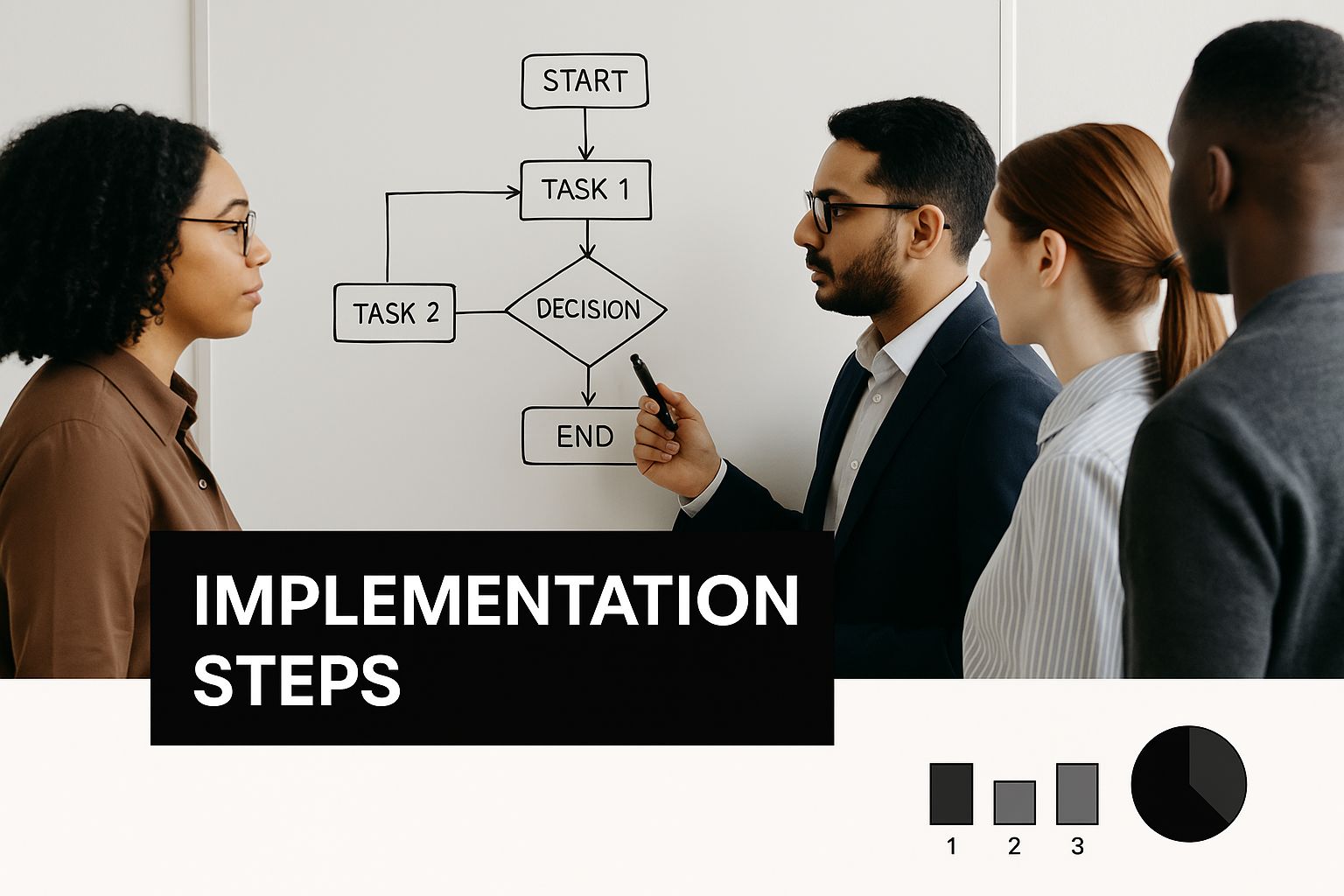Thinking about bringing AI into your business? Let's talk about the biggest mistake I see people make: they start with the technology. It's so easy to get excited about a flashy new tool and then try to find a problem for it to solve. That’s completely backward, and it's a recipe for wasted time and money.
Ready for a friendlier approach? Your AI journey should always start with a problem, not a tool.
Start with a Problem, Not a Tool
Getting into artificial intelligence can feel like a huge, complicated project, but I promise you, it doesn't have to be. The trick is to flip your perspective. Don't ask, "What cool things can we do with AI?" Instead, grab your team and ask, "What's our biggest operational headache, and could technology help fix it?" This small shift is everything.
And this isn't just for the big tech giants anymore. The use of artificial intelligence in business has absolutely exploded. Today, an estimated 78% of companies are using AI in some capacity, which is a massive leap from just 20% back in 2017. With over 90% of businesses now either using or actively exploring AI, it's pretty clear this is becoming a standard part of doing business. You can dig into more of those stats in this report on companies using AI from ExplodingTopics.com.
Finding Your "Why" Before Your "What"
Before you even think about looking at software demos, get your team in a room with a whiteboard (or a virtual one!). The goal here is to hunt for pain points, not solutions. A great way to kick this off is to map out your core business processes from start to finish.
Look for friction in areas like these:
- Customer Interaction: Where do your customers get frustrated? Are your support response times lagging? Is your team answering the same five questions over and over all day long? A great practical example is a small online store getting swamped with "Where is my order?" emails.
- Internal Operations: What mind-numbing, repetitive tasks are eating up your team's time? I’m talking about manual data entry, pulling together reports, or trying to coordinate schedules. Think about your bookkeeper manually reconciling invoices—that's a perfect spot for AI.
- Sales and Marketing: Is your sales team drowning in unqualified leads? Can you clearly see which marketing campaigns are actually making you money? Are you guessing at which customer segments to target next?
Let’s make this real. Imagine a local plumbing company. They might realize their office manager spends hours every single day just scheduling appointments and sending follow-up reminders. Their problem isn't a "lack of AI"—it's a scheduling bottleneck that's costing them time and money. An AI-powered scheduling assistant could solve that specific, tangible issue.
"A key lesson in years of academic research in management has shown us that culture eats strategy for breakfast. If you don’t understand the cultural aspects—the organizational aspects of change—then your best strategies will just simply not work."
- Karim Lakhani, Harvard Business School Professor
Karim’s point here is critical. The tech is only half the battle. Your whole approach, starting with finding the right problem to solve, is what determines whether your team actually adopts and benefits from any new tool. When you focus on a genuine business need, you build a natural case for change and get your people on board from the get-go.
Find Your First High-Impact AI Opportunity

It's easy to get dazzled by all the AI tools out there, but let’s hit the brakes for a second. The most successful AI projects I’ve seen don't start with the tech—they start with a real, nagging business problem. Before you even think about software, we need to pinpoint where AI can give you a tangible, early win. It’s all about adopting a "problem-first" mindset.
Think about the daily grind. What are those repetitive, low-value tasks that drain your team's time and energy? That's where you'll find gold. You're looking for the work that is both frustrating and frequent, the kind of stuff that makes people say, "There has to be a better way."
Uncover Your Hidden Opportunities
The best way to spot these opportunities is to look for the bottlenecks. Where do things get stuck? What slows everyone down? Start by having honest conversations with your team about their day-to-day work. You’ll be amazed at what you learn when you ask about friction points instead of just talking about features.
For example, I worked with a small e-commerce shop where the owner was spending nearly 10 hours a week just manually updating inventory across Etsy, Shopify, and their own website. That's a massive, high-impact problem. An AI-powered tool could automate the whole inventory forecasting and syncing process, literally giving them back a full day of work to focus on growing the business.
Or take a local dental clinic. Their receptionist was constantly overwhelmed with calls, just booking and rescheduling appointments. That’s another perfect use case. An AI chatbot on their website can now handle all of that 24/7, which not only frees up staff but also makes booking an appointment way easier for patients.
Prioritize Based on Impact and Effort
Once you’ve got a list of potential problems, it’s time to get strategic. Not all AI projects are created equal, and you don’t want your first one to be a massive, complex beast. The goal is to find a high-impact, low-complexity project to start with. This gives you an early win that builds momentum and gets the whole team on board.
Here's a simple way to do it. Create a basic evaluation matrix and score each idea on two things:
- Potential Impact: How much time or money could this realistically save? Will it dramatically improve the customer experience or boost revenue? (Score it from 1-10).
- Implementation Effort: How hard will this be to get up and running? Does it need a ton of data integration or specialized tech skills? (Score it 1-10, where 1 is easy and 10 is a nightmare).
Your sweet spot is a project with a high impact score and a low effort score. These are your prime candidates.
"The philosophy behind this is that artificial intelligence generates a huge range of opportunities for enterprises, so we don’t want to limit it to a specific thing. It’s not about one use case. It’s about generating lots of use cases."
- Marco Iansiti, Harvard Business School Professor
This is a key takeaway. Your first project isn't about solving every problem at once. It's about proving the concept, learning how this works in your business, and building a foundation for more.
From Ideas to a Shortlist
Let's walk through a real-world example. Imagine you run a small marketing agency. After talking with your team, you've identified three pain points:
- Automated Social Media Reporting: The team spends hours every month pulling data from a dozen different platforms just to build client reports. An AI tool could do this in minutes.
- AI-Powered Lead Scoring: The sales team feels like they're wasting time chasing leads that go nowhere. An AI system could analyze new leads and bubble the best ones to the top.
- Content Creation Assistant: Your writers could use an AI assistant to brainstorm blog post ideas and draft rough outlines, cutting down on "blank page syndrome."
Now, let's score them. The social media reporting project is a clear winner. It's high-impact (saves a ton of billable hours) and low-effort (plenty of excellent, plug-and-play tools exist for this). Lead scoring is also high-impact but might be trickier to set up correctly. The content assistant is probably lower-impact but very low-effort.
Based on this, automated reporting is the perfect pilot project. It solves a genuine pain point and delivers a clear, measurable win right out of the gate. This focused approach is the key to successful AI automation for businesses.
Choose the Right AI Tools Without the Headache
Okay, you’ve pinpointed a specific, high-impact problem. Now comes the fun part: picking the right tool to solve it. Walking into the AI marketplace can feel like stepping into a massive, noisy electronics store. Everything looks flashy, promising the world, and it's incredibly easy to get overwhelmed.
But here’s the good news: you don’t need a degree in data science to make a smart choice. We just need to simplify the landscape.
The Three Flavors of AI Solutions
I find it helps to think of AI solutions in three broad categories. Understanding these will help you focus your search and, more importantly, avoid paying for a bunch of features you'll never touch.
It's a bit like deciding on dinner. You can grab fast food (ready-to-go), use a meal kit (some assembly required), or cook a gourmet meal from scratch (fully custom). Each has its place.
To make it even clearer, let's break down the main types of AI solutions you'll encounter. This table should help you figure out where to start based on your company's resources, timeline, and technical comfort level.
Comparing AI Solution Types for Your Business
| Solution Type | Best For | Implementation Time | Cost | Example |
|---|---|---|---|---|
| Off-the-Shelf SaaS | Businesses new to AI, solving common problems, and needing quick wins. | Days to weeks | $ | An AI-powered CRM like Salesforce Einstein that automatically scores leads. |
| Customizable Platforms | Teams with some technical skill who need more flexibility than a fixed tool. | Weeks to months | $$ | Using Microsoft's Power Platform to build a custom chatbot for internal IT support. |
| Fully Custom Solutions | Large enterprises with unique, complex problems and dedicated data science teams. | Months to years | $$$ | Building a proprietary fraud detection algorithm from the ground up for a financial institution. |
For most businesses just dipping their toes into AI, off-the-shelf tools are absolutely the sweet spot. They deliver real value almost immediately with minimal fuss.
Once you start on this path, having a structured plan is key.

This kind of workflow helps everyone on your team see the big picture, making the entire adoption process feel much smoother and more predictable.
Your Checklist for Picking the Right Tool
When you start looking at specific off-the-shelf options, it’s tempting to get dazzled by a long list of features. Resist that urge. Instead, zero in on a few criteria that actually predict whether a tool will be successful in your organization.
Keep this short checklist handy during your demos and research:
- Is it actually easy to use? Seriously, can your least tech-savvy team member figure out the basics without a week of training? If an interface is clunky, your team just won't use it. End of story.
- Does it play well with others? The new tool needs to connect seamlessly with the software you already rely on. Check for native integrations with your CRM, email platform, and project management system. It should feel like a helpful colleague, not an isolated piece of tech.
- Can it grow with us? You might only need it for a five-person team today, but what happens next year when you've doubled in size? Look for pricing plans and features that scale, so you aren't forced to migrate to a new system down the road.
- Is the pricing clear and predictable? Avoid tools with confusing, usage-based pricing models that can lead to shocking bills. You want a straightforward monthly or annual fee that you can actually budget for.
This focused approach helps you cut through the marketing fluff and choose a tool that will genuinely move the needle. The ecosystem is always evolving, too. For instance, you can learn more about the introduction of new apps within ChatGPT to see how even major platforms are becoming more like toolkits.
"Focus on tools that solve one specific problem exceptionally well. Don't pay for a complex platform when a simple, focused app will deliver 90% of the value for 10% of the cost."
- Expert Consultant Takeaway
This piece of advice is gold. When you're implementing AI for the first time, the goal isn't to boil the ocean. It's to get a quick, measurable win that solves a real, nagging problem. Choosing a targeted, effective tool over an all-in-one "AI powerhouse" is the smartest first move you can make.
Launch a Winning AI Pilot Project
So, you’ve picked out a solid business problem and found an AI tool that looks promising. Now for the exciting part—where all that planning meets the real world. A great pilot project is the make-or-break moment for any AI rollout. Think of it as a test flight. You're trying to prove the concept works, spot any turbulence, and build confidence before you commit fully.
The secret at this stage is to start small and stay laser-focused. Forget about putting together a massive task force. For most pilot projects, a small, nimble team is way more effective.
Assemble Your A-Team
You really don't need an army for your first AI initiative. In my experience, a smaller group can move much faster and communicate without getting wires crossed. Your core pilot team only needs a few key people:
- The Project Lead: This is your champion. They're the one keeping the project on track, managing the timeline, and reporting on how things are going.
- The Vendor Contact: You'll want a dedicated person from the software company who can handle technical questions and help you troubleshoot when things get tricky.
- The End User: This is probably the most critical person on the team. It has to be someone who will actually use the tool every single day. Their feedback from the trenches is gold.
Honestly, that’s often all you need. A tight-knit group like this avoids getting bogged down in red tape and can make quick decisions as you go.
Define What Success Actually Looks Like
Before you flip a single switch, you need to know what you’re aiming for. Vague goals like “improve efficiency” are useless here. You have to set clear, measurable Key Performance Indicators (KPIs) from the very beginning. It's the only way you'll know for sure if the pilot was a success.
So, what does that look like in practice?
- If you’re testing an AI chatbot for customer service, a solid KPI might be to reduce initial customer response time by 20%.
- For an AI-powered sales tool, you could aim to increase the number of qualified leads by 15% in the first quarter.
- If you're automating data entry, the goal could be to cut down manual processing hours by 50%.
Setting these concrete targets gives your pilot project a clear purpose and makes it simple to measure your return on investment.
"The point of a pilot isn't perfection; it's about learning. You're trying to validate the solution, get honest feedback, and build momentum. This 'start small, learn fast' approach keeps risk low and teaches you critical lessons for every AI project that follows."
- Andrew Ng, Co-founder of Google Brain & Coursera
This mindset is everything. Don’t expect it all to work flawlessly on day one. Your pilot is the chance to learn, adapt, and prove the value of AI on a scale you can easily manage.
Get Your Data Ready for AI
One of the most critical steps people often skip is data preparation. Your AI tool is only as smart as the information you give it. If you feed it messy, irrelevant, or incomplete data, you’ll get messy, irrelevant, and incomplete results. It's the classic "garbage in, garbage out" scenario.
Before you begin, spend some real time cleaning and organizing the data your new tool will be using. This might mean getting rid of duplicate customer records in your CRM or making sure product information is consistent across your spreadsheets. A little bit of this upfront work saves you from a world of headaches down the road.
This might sound like a huge undertaking, but you can move surprisingly fast. Many mid-sized companies get new AI solutions up and running in as little as 90 days because integrations are getting easier and there are fewer technical hoops to jump through. And the results speak for themselves—some businesses report a 40% improvement in operational efficiency, while others see incredible growth. You can read more about how top companies are finding success in this insightful article on the Inc. 5000 and AI.
Scale AI From a Single Win to a Business Strategy

Your pilot project was a success—fantastic! That first win feels great, but it’s really just the starting line. The real challenge, and where I see so many businesses get stuck, is turning that isolated victory into a full-blown strategy. You've built momentum; the last thing you want is to waste it.
Scaling AI isn’t about just adding more software licenses. It's about fundamentally rewiring how your business operates. The goal is to evolve from "a company that uses an AI tool" to "an AI-powered company." That shift takes a solid plan, the right culture, and a clear vision.
Building Your AI Roadmap
You now have a proven concept, along with real-world data and lessons learned from your pilot. It’s time to use that insight to build a strategic roadmap. This isn't a wish list of cool projects; it's a prioritized plan that directly supports your business goals for the next one to three years.
Are you trying to boost customer retention? Break into a new market? Unclog your supply chain? Your AI roadmap needs to be the engine that drives those objectives forward.
Here’s how I advise clients to start prioritizing what comes next:
- Build on Your Success: Look for similar problems in adjacent departments. For instance, if you nailed automating customer service FAQs, could that same approach create an internal knowledge base for your HR or IT teams? The groundwork is already done.
- Target Bigger Opportunities: Your pilot was likely a low-risk, high-impact project. Now you can confidently take on initiatives with a much higher ROI, even if they're a bit more complex.
- Connect the Dots: Start thinking about how different AI tools can work together. Imagine connecting an AI marketing tool that captures leads with an AI sales assistant that qualifies them instantly. That’s where the magic really happens.
This isn’t just a trend; it's a massive economic shift. The global AI market has already hit around $391 billion and is on track to quintuple in the next five years. It's no surprise that 83% of businesses now call AI a top strategic priority.
Cultivating an AI-Ready Culture
Technology is only half the battle. The other half—the more critical half—is your people. A company-wide AI strategy will live or die based on a culture where your team feels empowered by the tech, not threatened by it.
Resistance almost always comes from a fear of the unknown. People worry that AI is coming for their jobs. You have to get out in front of that narrative with clear, consistent communication.
"Your message should be simple and direct: AI is here to kill the boring parts of your job so you can focus on the creative, strategic work that moves the needle. It's a tool to make you better, not to replace you."
- Sarah Franklin, President and CMO of Salesforce
Frame AI as an assistant that handles the grunt work. A marketing specialist no longer has to spend hours pulling data for reports; an AI tool does it in seconds. Now they have time to analyze the results and build smarter campaigns. This cultural shift is vital everywhere, though the specifics can vary. For example, understanding the nuances of accelerating AI adoption in Europe can offer great lessons on managing this kind of change.
From Proof to Investment
With a successful pilot and hard ROI numbers in your back pocket, asking for a bigger investment is a completely different conversation. You’re no longer saying, "I think this could work." You’re saying, "I have data showing this does work, and here’s what we can accomplish next."
When you build your business case, get specific. Don’t just talk about "efficiency"; quantify it.
- Time Saved: "Our pilot saved the customer service team 40 hours per month."
- Cost Reduction: "By automating inventory checks, we cut overstock costs by 18%."
- Revenue Growth: "The AI lead-scoring tool drove a 22% increase in qualified leads."
Present this data clearly to leadership. Show them exactly how each proposed project ties back to a measurable business outcome. This evidence-based approach makes it much, much easier to get the budget you need to truly weave AI into the DNA of your business.
Answering Your Questions About AI in Business
Jumping into AI can feel a bit like learning a new language. You know it’s important, but a million questions pop up the moment you start. Let's break down some of the most common ones I hear from business owners who are figuring out how to make AI work for them.
What’s This Actually Going to Cost Me?
This is always the first question, and the answer is almost always "less than you think." The cost of AI isn't a single, scary number; it’s a huge spectrum. We're not talking about needing a Silicon Valley-sized budget for a custom-built system.
For most small and medium-sized businesses, the starting point is surprisingly affordable. A lot of the best AI tools out there operate on a simple SaaS (Software as a Service) model.
Here’s a realistic look at what you might spend:
- Simple Automation Tools: Think of an AI that schedules your social media posts or a basic chatbot for your website. These often start anywhere from $25 to $100 per month.
- AI-Enhanced CRMs: Maybe you want a platform that helps score sales leads or personalize marketing emails. Plans for these often start in the $50 to $300 per month range, usually scaling with your team size.
- Specialized Software: If you need something more specific, like a tool for inventory forecasting or deep financial analysis, you might be looking at a few hundred dollars a month.
The trick is to start small. Find one specific, nagging problem and find a tool that fixes it. You'd be amazed at the ROI you can get from a tool that costs less than your company's weekly coffee run.
I Don't Have a Tech Team. Can I Still Do This?
This is a massive—and totally valid—concern. The great news? You absolutely do not need an in-house team of data scientists and developers to get started. In fact, this whole new wave of AI tools is built specifically for people who aren't technical.
I like to think of it this way: you don't need to know how a car engine works to drive a car. It's the same idea here. You don't have to understand the complex algorithms humming away in the background to get the benefits. Modern AI software is all about user-friendly dashboards, drag-and-drop features, and simple integrations.
Most of these tools are packed with support documentation, video tutorials, and real human support teams ready to walk you through setup. Honestly, if you can set up a new LinkedIn profile or figure out a project management tool like Asana or Trello, you have all the skills you need to roll out many of today's best AI solutions.
"The whole point of modern business AI is to make it accessible. The companies building these tools know their customers are business owners and marketers, not engineers. They only succeed if you can get up and running fast, without having to hire a specialist."
- Expert Consultant Takeaway
How Do I Know My Business Data Is Safe?
Trusting a new platform with your company and customer data is a big deal. Data security has to be at the top of your checklist when you're looking at any new tool, AI-powered or not.
Any AI vendor worth their salt knows this and invests heavily in security. When you’re vetting potential tools, here are a few things you should always look for:
- Compliance Certifications: Keep an eye out for standards like SOC 2 or ISO 27001. These aren't just fancy acronyms; they are independent audits that prove a company has its security act together.
- Data Encryption: Make sure they encrypt your data both when it's just sitting on their servers (at rest) and when it's being sent back and forth (in transit). This is table stakes for security and is completely non-negotiable.
- Clear Privacy Policies: Actually read their privacy policy. It should spell out exactly how your data is used, who can access it, and—most importantly—that you always remain the owner of your own information.
Don't ever feel shy about asking a vendor's sales or support team direct questions about their security practices. If they give you vague answers or can't speak confidently about it, that's a huge red flag. Your data is one of your most valuable assets; any partner you work with should treat it that way.
At YourAI2Day, we cut through the noise to bring you practical guides and the latest news on AI tools that can genuinely help your business grow. Explore our resources to stay ahead of the curve at https://www.yourai2day.com.





